Sociology Essay: Factors of Family Change in Australia
VerifiedAdded on 2020/03/16
|8
|1751
|74
Essay
AI Summary
This sociology essay examines the evolving dynamics of family life in Australia, focusing on the significant shifts that have occurred since the mid-twentieth century. It explores the changing concepts of love and mate selection, contrasting arranged marriages with modern, love-based unions. The essay analyzes marital satisfaction and divorce rates, highlighting the impact of women's increased independence and evolving societal values. It delves into reproductive choices, including the influence of contraception and assisted reproductive technologies, and discusses the changing roles in housework and childcare, emphasizing the shift towards greater gender equality. The conclusion synthesizes these trends, emphasizing the impact of changing individual aspirations and societal values on the structure and function of families in Australia.
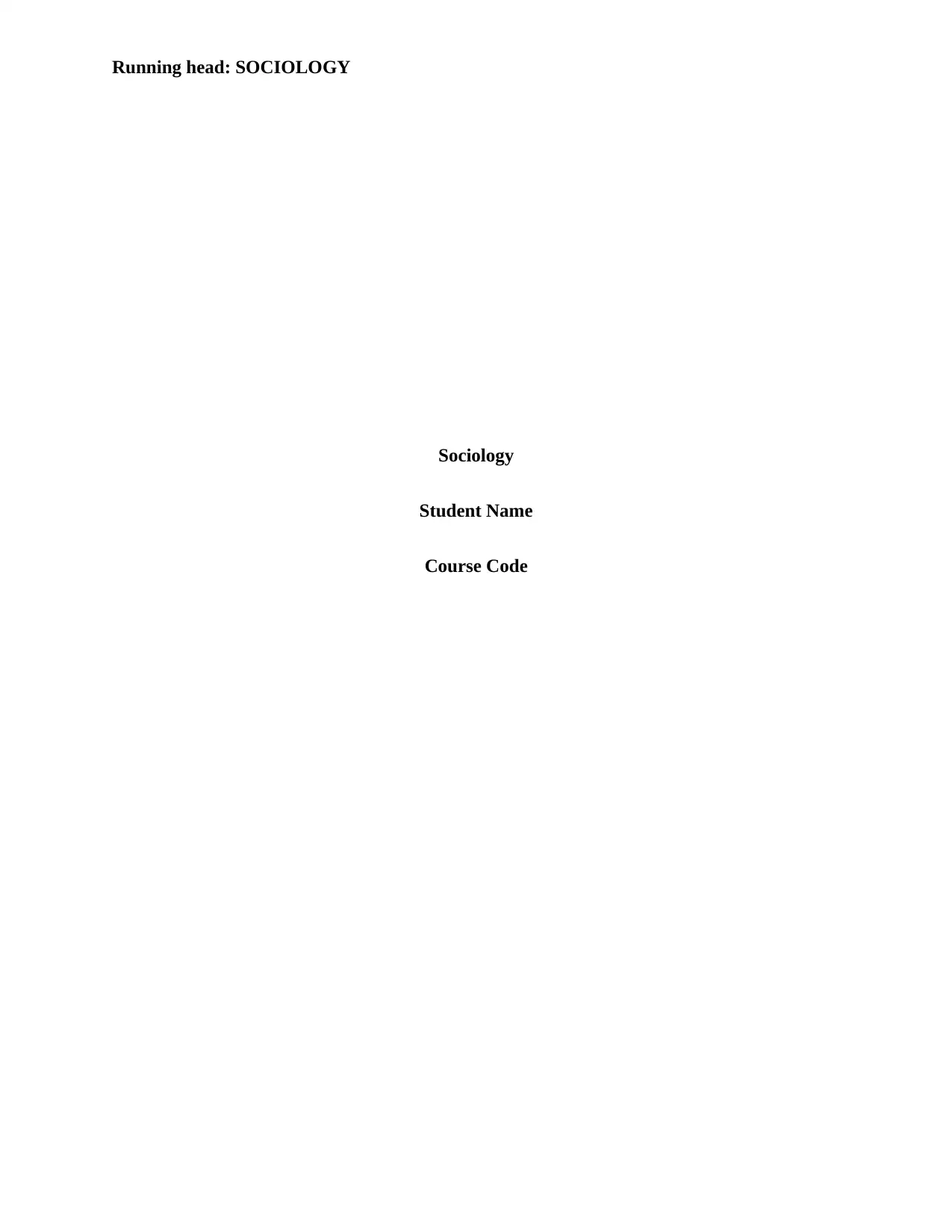
Running head: SOCIOLOGY
Sociology
Student Name
Course Code
Sociology
Student Name
Course Code
Paraphrase This Document
Need a fresh take? Get an instant paraphrase of this document with our AI Paraphraser
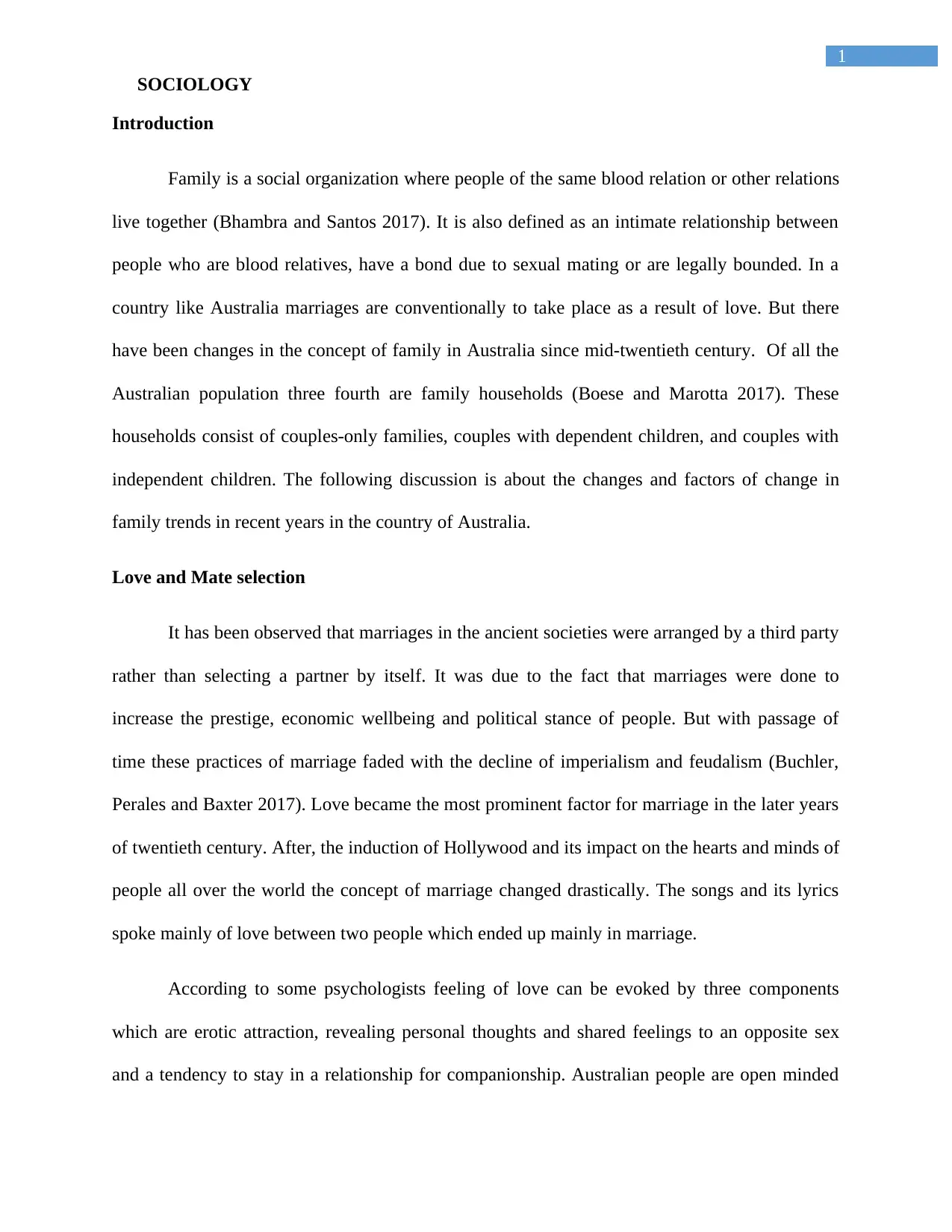
1
SOCIOLOGY
Introduction
Family is a social organization where people of the same blood relation or other relations
live together (Bhambra and Santos 2017). It is also defined as an intimate relationship between
people who are blood relatives, have a bond due to sexual mating or are legally bounded. In a
country like Australia marriages are conventionally to take place as a result of love. But there
have been changes in the concept of family in Australia since mid-twentieth century. Of all the
Australian population three fourth are family households (Boese and Marotta 2017). These
households consist of couples-only families, couples with dependent children, and couples with
independent children. The following discussion is about the changes and factors of change in
family trends in recent years in the country of Australia.
Love and Mate selection
It has been observed that marriages in the ancient societies were arranged by a third party
rather than selecting a partner by itself. It was due to the fact that marriages were done to
increase the prestige, economic wellbeing and political stance of people. But with passage of
time these practices of marriage faded with the decline of imperialism and feudalism (Buchler,
Perales and Baxter 2017). Love became the most prominent factor for marriage in the later years
of twentieth century. After, the induction of Hollywood and its impact on the hearts and minds of
people all over the world the concept of marriage changed drastically. The songs and its lyrics
spoke mainly of love between two people which ended up mainly in marriage.
According to some psychologists feeling of love can be evoked by three components
which are erotic attraction, revealing personal thoughts and shared feelings to an opposite sex
and a tendency to stay in a relationship for companionship. Australian people are open minded
SOCIOLOGY
Introduction
Family is a social organization where people of the same blood relation or other relations
live together (Bhambra and Santos 2017). It is also defined as an intimate relationship between
people who are blood relatives, have a bond due to sexual mating or are legally bounded. In a
country like Australia marriages are conventionally to take place as a result of love. But there
have been changes in the concept of family in Australia since mid-twentieth century. Of all the
Australian population three fourth are family households (Boese and Marotta 2017). These
households consist of couples-only families, couples with dependent children, and couples with
independent children. The following discussion is about the changes and factors of change in
family trends in recent years in the country of Australia.
Love and Mate selection
It has been observed that marriages in the ancient societies were arranged by a third party
rather than selecting a partner by itself. It was due to the fact that marriages were done to
increase the prestige, economic wellbeing and political stance of people. But with passage of
time these practices of marriage faded with the decline of imperialism and feudalism (Buchler,
Perales and Baxter 2017). Love became the most prominent factor for marriage in the later years
of twentieth century. After, the induction of Hollywood and its impact on the hearts and minds of
people all over the world the concept of marriage changed drastically. The songs and its lyrics
spoke mainly of love between two people which ended up mainly in marriage.
According to some psychologists feeling of love can be evoked by three components
which are erotic attraction, revealing personal thoughts and shared feelings to an opposite sex
and a tendency to stay in a relationship for companionship. Australian people are open minded
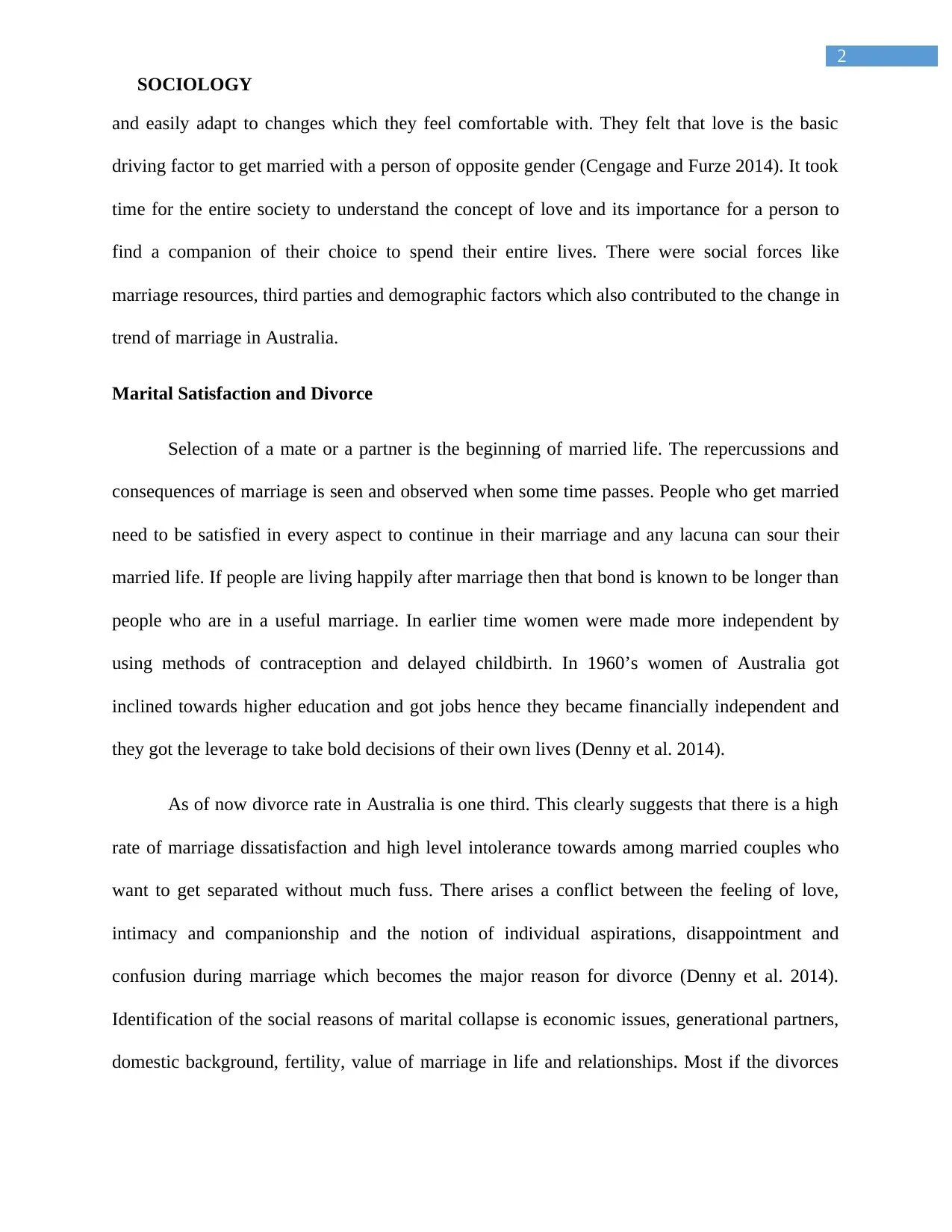
2
SOCIOLOGY
and easily adapt to changes which they feel comfortable with. They felt that love is the basic
driving factor to get married with a person of opposite gender (Cengage and Furze 2014). It took
time for the entire society to understand the concept of love and its importance for a person to
find a companion of their choice to spend their entire lives. There were social forces like
marriage resources, third parties and demographic factors which also contributed to the change in
trend of marriage in Australia.
Marital Satisfaction and Divorce
Selection of a mate or a partner is the beginning of married life. The repercussions and
consequences of marriage is seen and observed when some time passes. People who get married
need to be satisfied in every aspect to continue in their marriage and any lacuna can sour their
married life. If people are living happily after marriage then that bond is known to be longer than
people who are in a useful marriage. In earlier time women were made more independent by
using methods of contraception and delayed childbirth. In 1960’s women of Australia got
inclined towards higher education and got jobs hence they became financially independent and
they got the leverage to take bold decisions of their own lives (Denny et al. 2014).
As of now divorce rate in Australia is one third. This clearly suggests that there is a high
rate of marriage dissatisfaction and high level intolerance towards among married couples who
want to get separated without much fuss. There arises a conflict between the feeling of love,
intimacy and companionship and the notion of individual aspirations, disappointment and
confusion during marriage which becomes the major reason for divorce (Denny et al. 2014).
Identification of the social reasons of marital collapse is economic issues, generational partners,
domestic background, fertility, value of marriage in life and relationships. Most if the divorces
SOCIOLOGY
and easily adapt to changes which they feel comfortable with. They felt that love is the basic
driving factor to get married with a person of opposite gender (Cengage and Furze 2014). It took
time for the entire society to understand the concept of love and its importance for a person to
find a companion of their choice to spend their entire lives. There were social forces like
marriage resources, third parties and demographic factors which also contributed to the change in
trend of marriage in Australia.
Marital Satisfaction and Divorce
Selection of a mate or a partner is the beginning of married life. The repercussions and
consequences of marriage is seen and observed when some time passes. People who get married
need to be satisfied in every aspect to continue in their marriage and any lacuna can sour their
married life. If people are living happily after marriage then that bond is known to be longer than
people who are in a useful marriage. In earlier time women were made more independent by
using methods of contraception and delayed childbirth. In 1960’s women of Australia got
inclined towards higher education and got jobs hence they became financially independent and
they got the leverage to take bold decisions of their own lives (Denny et al. 2014).
As of now divorce rate in Australia is one third. This clearly suggests that there is a high
rate of marriage dissatisfaction and high level intolerance towards among married couples who
want to get separated without much fuss. There arises a conflict between the feeling of love,
intimacy and companionship and the notion of individual aspirations, disappointment and
confusion during marriage which becomes the major reason for divorce (Denny et al. 2014).
Identification of the social reasons of marital collapse is economic issues, generational partners,
domestic background, fertility, value of marriage in life and relationships. Most if the divorces
⊘ This is a preview!⊘
Do you want full access?
Subscribe today to unlock all pages.

Trusted by 1+ million students worldwide
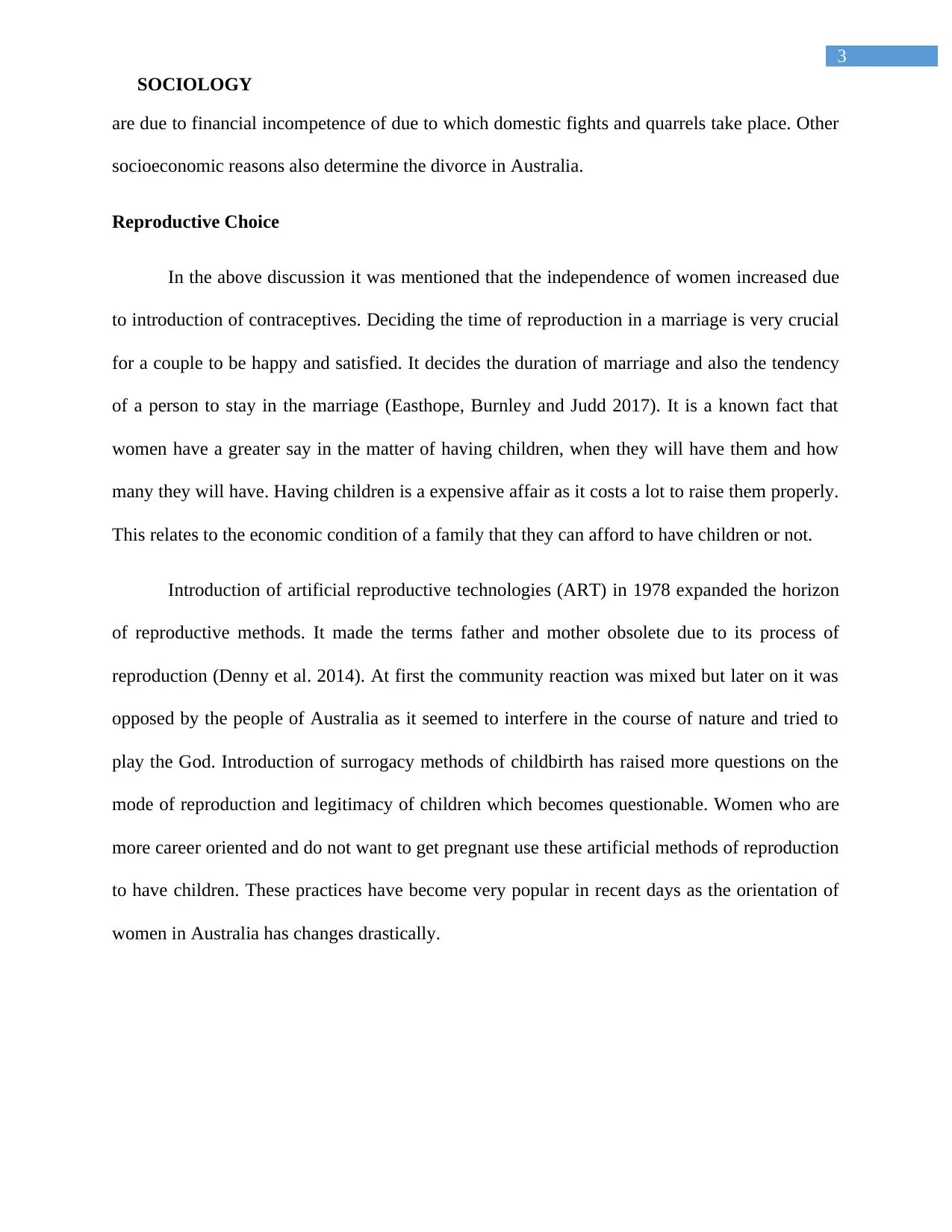
3
SOCIOLOGY
are due to financial incompetence of due to which domestic fights and quarrels take place. Other
socioeconomic reasons also determine the divorce in Australia.
Reproductive Choice
In the above discussion it was mentioned that the independence of women increased due
to introduction of contraceptives. Deciding the time of reproduction in a marriage is very crucial
for a couple to be happy and satisfied. It decides the duration of marriage and also the tendency
of a person to stay in the marriage (Easthope, Burnley and Judd 2017). It is a known fact that
women have a greater say in the matter of having children, when they will have them and how
many they will have. Having children is a expensive affair as it costs a lot to raise them properly.
This relates to the economic condition of a family that they can afford to have children or not.
Introduction of artificial reproductive technologies (ART) in 1978 expanded the horizon
of reproductive methods. It made the terms father and mother obsolete due to its process of
reproduction (Denny et al. 2014). At first the community reaction was mixed but later on it was
opposed by the people of Australia as it seemed to interfere in the course of nature and tried to
play the God. Introduction of surrogacy methods of childbirth has raised more questions on the
mode of reproduction and legitimacy of children which becomes questionable. Women who are
more career oriented and do not want to get pregnant use these artificial methods of reproduction
to have children. These practices have become very popular in recent days as the orientation of
women in Australia has changes drastically.
SOCIOLOGY
are due to financial incompetence of due to which domestic fights and quarrels take place. Other
socioeconomic reasons also determine the divorce in Australia.
Reproductive Choice
In the above discussion it was mentioned that the independence of women increased due
to introduction of contraceptives. Deciding the time of reproduction in a marriage is very crucial
for a couple to be happy and satisfied. It decides the duration of marriage and also the tendency
of a person to stay in the marriage (Easthope, Burnley and Judd 2017). It is a known fact that
women have a greater say in the matter of having children, when they will have them and how
many they will have. Having children is a expensive affair as it costs a lot to raise them properly.
This relates to the economic condition of a family that they can afford to have children or not.
Introduction of artificial reproductive technologies (ART) in 1978 expanded the horizon
of reproductive methods. It made the terms father and mother obsolete due to its process of
reproduction (Denny et al. 2014). At first the community reaction was mixed but later on it was
opposed by the people of Australia as it seemed to interfere in the course of nature and tried to
play the God. Introduction of surrogacy methods of childbirth has raised more questions on the
mode of reproduction and legitimacy of children which becomes questionable. Women who are
more career oriented and do not want to get pregnant use these artificial methods of reproduction
to have children. These practices have become very popular in recent days as the orientation of
women in Australia has changes drastically.
Paraphrase This Document
Need a fresh take? Get an instant paraphrase of this document with our AI Paraphraser
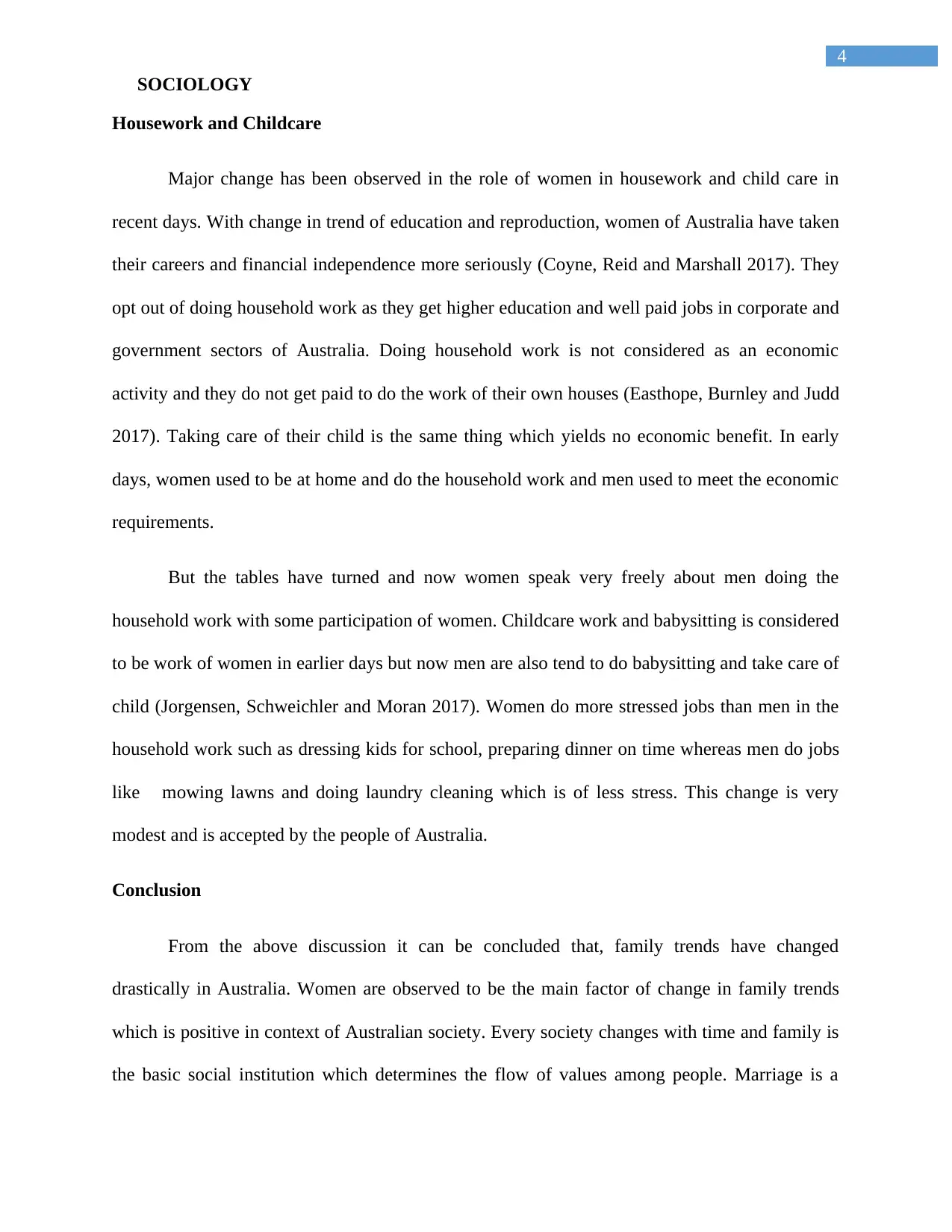
4
SOCIOLOGY
Housework and Childcare
Major change has been observed in the role of women in housework and child care in
recent days. With change in trend of education and reproduction, women of Australia have taken
their careers and financial independence more seriously (Coyne, Reid and Marshall 2017). They
opt out of doing household work as they get higher education and well paid jobs in corporate and
government sectors of Australia. Doing household work is not considered as an economic
activity and they do not get paid to do the work of their own houses (Easthope, Burnley and Judd
2017). Taking care of their child is the same thing which yields no economic benefit. In early
days, women used to be at home and do the household work and men used to meet the economic
requirements.
But the tables have turned and now women speak very freely about men doing the
household work with some participation of women. Childcare work and babysitting is considered
to be work of women in earlier days but now men are also tend to do babysitting and take care of
child (Jorgensen, Schweichler and Moran 2017). Women do more stressed jobs than men in the
household work such as dressing kids for school, preparing dinner on time whereas men do jobs
like mowing lawns and doing laundry cleaning which is of less stress. This change is very
modest and is accepted by the people of Australia.
Conclusion
From the above discussion it can be concluded that, family trends have changed
drastically in Australia. Women are observed to be the main factor of change in family trends
which is positive in context of Australian society. Every society changes with time and family is
the basic social institution which determines the flow of values among people. Marriage is a
SOCIOLOGY
Housework and Childcare
Major change has been observed in the role of women in housework and child care in
recent days. With change in trend of education and reproduction, women of Australia have taken
their careers and financial independence more seriously (Coyne, Reid and Marshall 2017). They
opt out of doing household work as they get higher education and well paid jobs in corporate and
government sectors of Australia. Doing household work is not considered as an economic
activity and they do not get paid to do the work of their own houses (Easthope, Burnley and Judd
2017). Taking care of their child is the same thing which yields no economic benefit. In early
days, women used to be at home and do the household work and men used to meet the economic
requirements.
But the tables have turned and now women speak very freely about men doing the
household work with some participation of women. Childcare work and babysitting is considered
to be work of women in earlier days but now men are also tend to do babysitting and take care of
child (Jorgensen, Schweichler and Moran 2017). Women do more stressed jobs than men in the
household work such as dressing kids for school, preparing dinner on time whereas men do jobs
like mowing lawns and doing laundry cleaning which is of less stress. This change is very
modest and is accepted by the people of Australia.
Conclusion
From the above discussion it can be concluded that, family trends have changed
drastically in Australia. Women are observed to be the main factor of change in family trends
which is positive in context of Australian society. Every society changes with time and family is
the basic social institution which determines the flow of values among people. Marriage is a
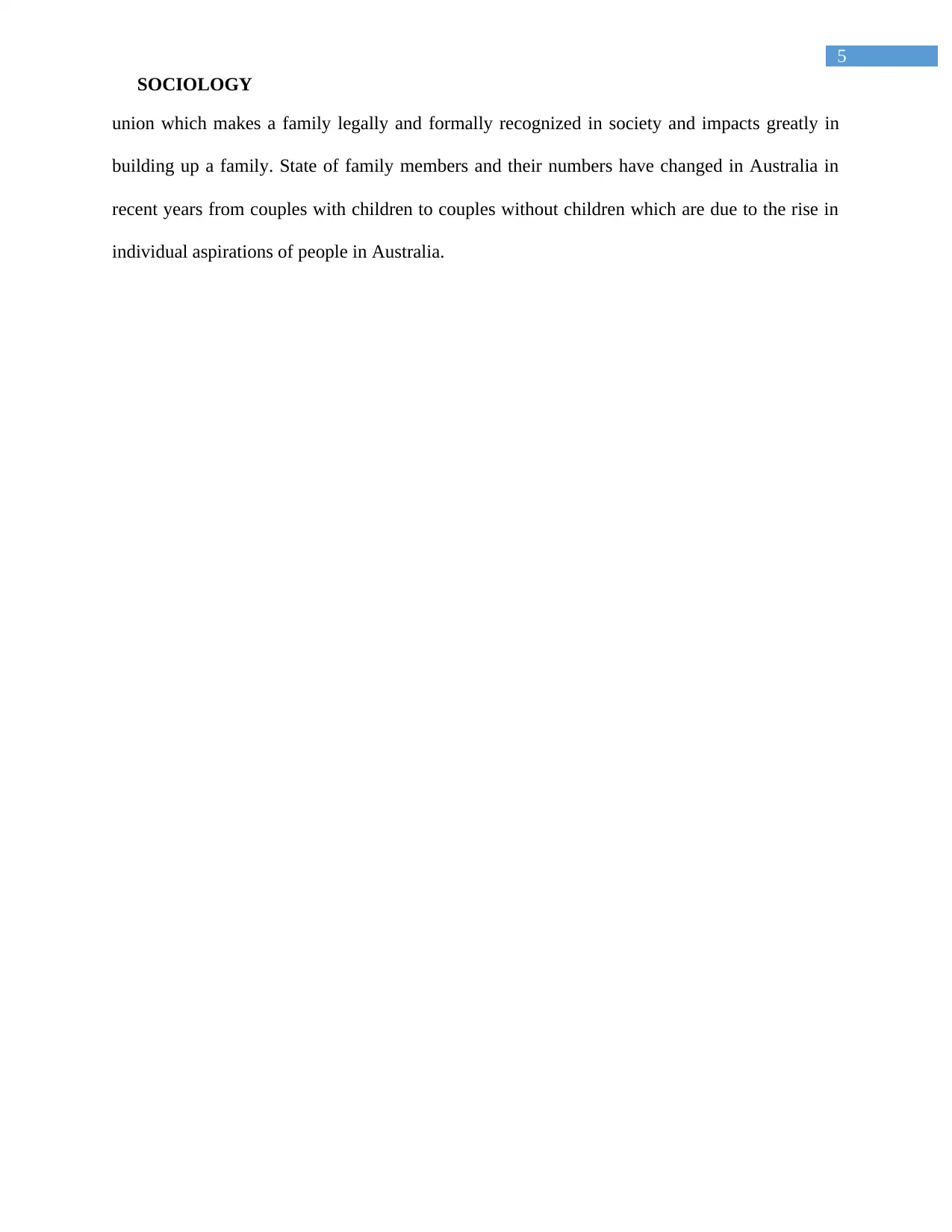
5
SOCIOLOGY
union which makes a family legally and formally recognized in society and impacts greatly in
building up a family. State of family members and their numbers have changed in Australia in
recent years from couples with children to couples without children which are due to the rise in
individual aspirations of people in Australia.
SOCIOLOGY
union which makes a family legally and formally recognized in society and impacts greatly in
building up a family. State of family members and their numbers have changed in Australia in
recent years from couples with children to couples without children which are due to the rise in
individual aspirations of people in Australia.
⊘ This is a preview!⊘
Do you want full access?
Subscribe today to unlock all pages.

Trusted by 1+ million students worldwide
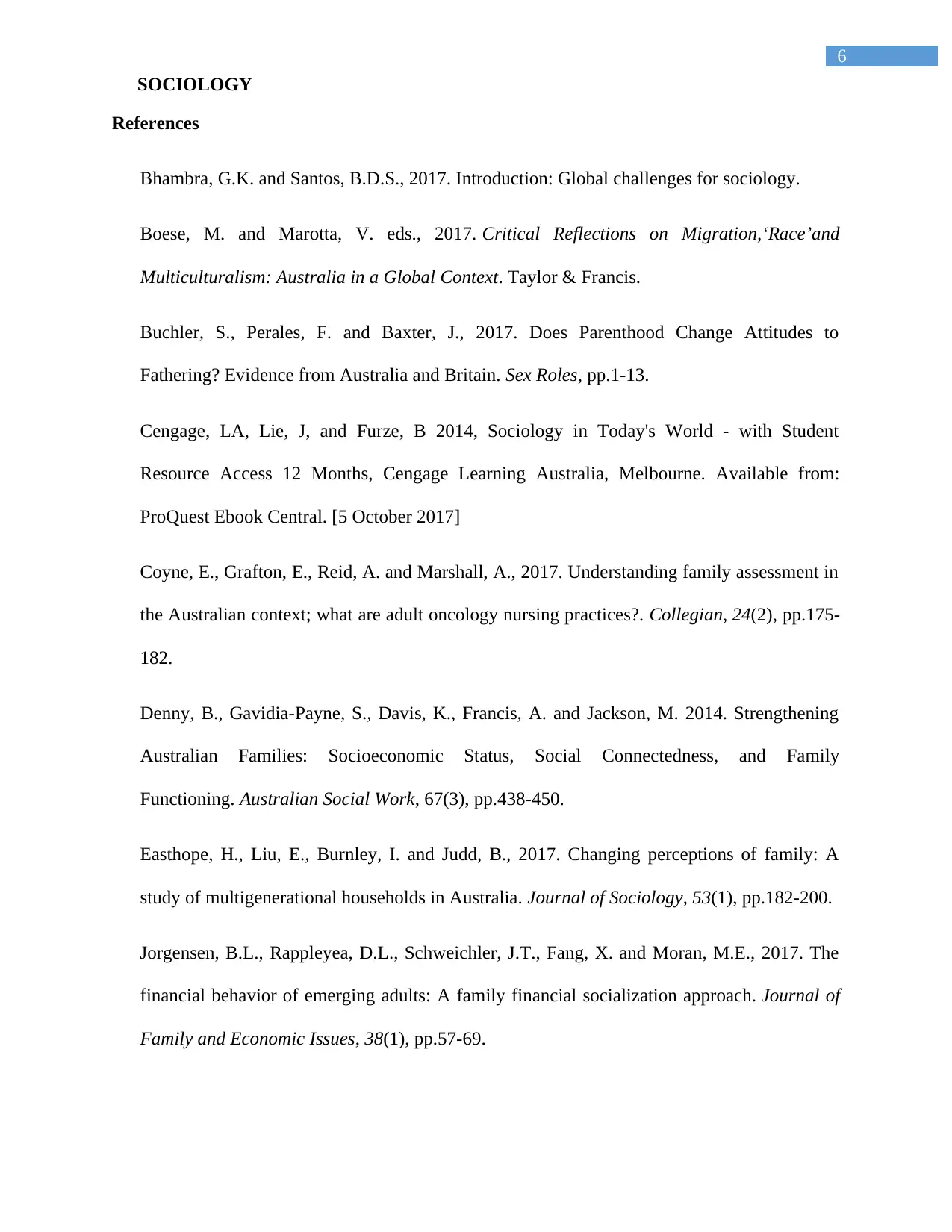
6
SOCIOLOGY
References
Bhambra, G.K. and Santos, B.D.S., 2017. Introduction: Global challenges for sociology.
Boese, M. and Marotta, V. eds., 2017. Critical Reflections on Migration,‘Race’and
Multiculturalism: Australia in a Global Context. Taylor & Francis.
Buchler, S., Perales, F. and Baxter, J., 2017. Does Parenthood Change Attitudes to
Fathering? Evidence from Australia and Britain. Sex Roles, pp.1-13.
Cengage, LA, Lie, J, and Furze, B 2014, Sociology in Today's World - with Student
Resource Access 12 Months, Cengage Learning Australia, Melbourne. Available from:
ProQuest Ebook Central. [5 October 2017]
Coyne, E., Grafton, E., Reid, A. and Marshall, A., 2017. Understanding family assessment in
the Australian context; what are adult oncology nursing practices?. Collegian, 24(2), pp.175-
182.
Denny, B., Gavidia-Payne, S., Davis, K., Francis, A. and Jackson, M. 2014. Strengthening
Australian Families: Socioeconomic Status, Social Connectedness, and Family
Functioning. Australian Social Work, 67(3), pp.438-450.
Easthope, H., Liu, E., Burnley, I. and Judd, B., 2017. Changing perceptions of family: A
study of multigenerational households in Australia. Journal of Sociology, 53(1), pp.182-200.
Jorgensen, B.L., Rappleyea, D.L., Schweichler, J.T., Fang, X. and Moran, M.E., 2017. The
financial behavior of emerging adults: A family financial socialization approach. Journal of
Family and Economic Issues, 38(1), pp.57-69.
SOCIOLOGY
References
Bhambra, G.K. and Santos, B.D.S., 2017. Introduction: Global challenges for sociology.
Boese, M. and Marotta, V. eds., 2017. Critical Reflections on Migration,‘Race’and
Multiculturalism: Australia in a Global Context. Taylor & Francis.
Buchler, S., Perales, F. and Baxter, J., 2017. Does Parenthood Change Attitudes to
Fathering? Evidence from Australia and Britain. Sex Roles, pp.1-13.
Cengage, LA, Lie, J, and Furze, B 2014, Sociology in Today's World - with Student
Resource Access 12 Months, Cengage Learning Australia, Melbourne. Available from:
ProQuest Ebook Central. [5 October 2017]
Coyne, E., Grafton, E., Reid, A. and Marshall, A., 2017. Understanding family assessment in
the Australian context; what are adult oncology nursing practices?. Collegian, 24(2), pp.175-
182.
Denny, B., Gavidia-Payne, S., Davis, K., Francis, A. and Jackson, M. 2014. Strengthening
Australian Families: Socioeconomic Status, Social Connectedness, and Family
Functioning. Australian Social Work, 67(3), pp.438-450.
Easthope, H., Liu, E., Burnley, I. and Judd, B., 2017. Changing perceptions of family: A
study of multigenerational households in Australia. Journal of Sociology, 53(1), pp.182-200.
Jorgensen, B.L., Rappleyea, D.L., Schweichler, J.T., Fang, X. and Moran, M.E., 2017. The
financial behavior of emerging adults: A family financial socialization approach. Journal of
Family and Economic Issues, 38(1), pp.57-69.
Paraphrase This Document
Need a fresh take? Get an instant paraphrase of this document with our AI Paraphraser
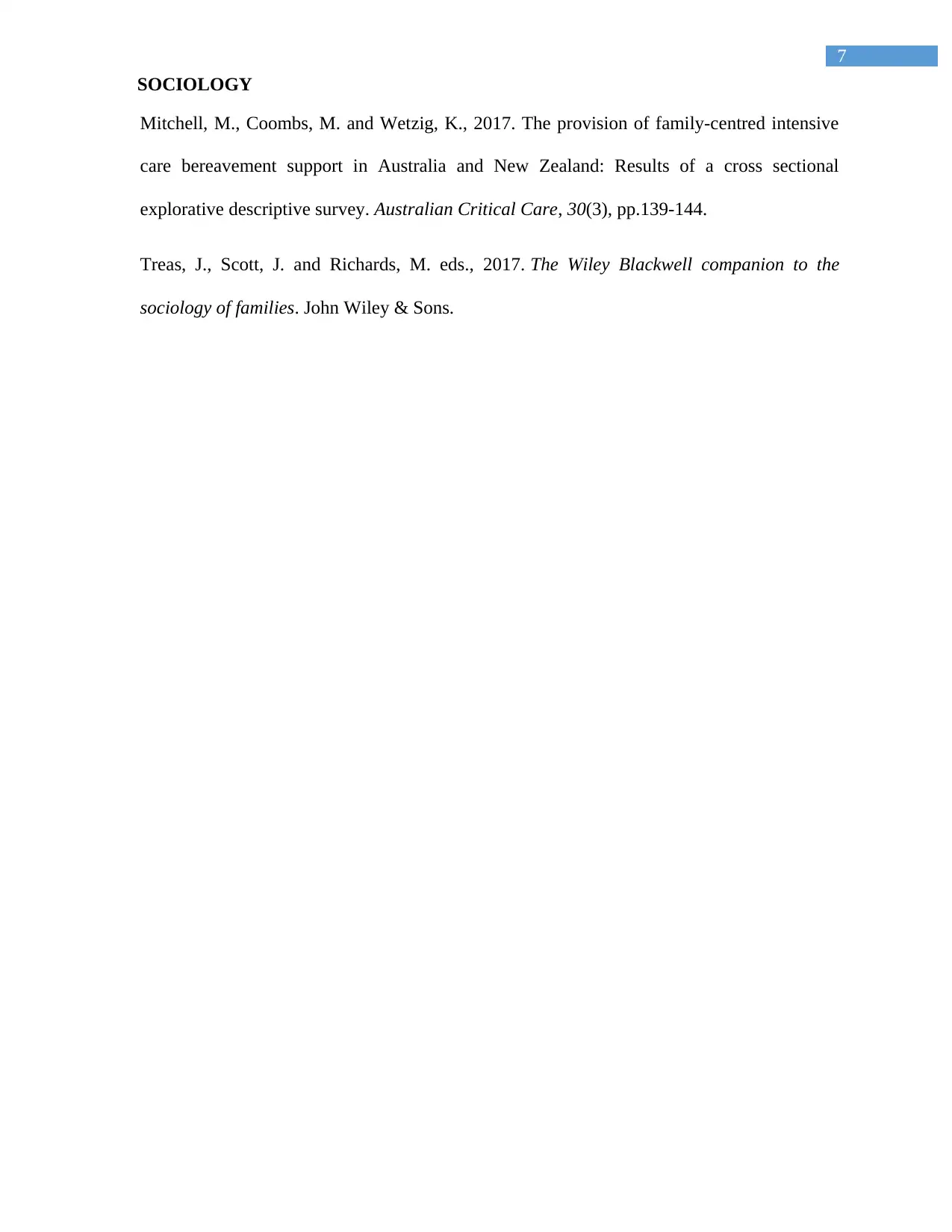
7
SOCIOLOGY
Mitchell, M., Coombs, M. and Wetzig, K., 2017. The provision of family-centred intensive
care bereavement support in Australia and New Zealand: Results of a cross sectional
explorative descriptive survey. Australian Critical Care, 30(3), pp.139-144.
Treas, J., Scott, J. and Richards, M. eds., 2017. The Wiley Blackwell companion to the
sociology of families. John Wiley & Sons.
SOCIOLOGY
Mitchell, M., Coombs, M. and Wetzig, K., 2017. The provision of family-centred intensive
care bereavement support in Australia and New Zealand: Results of a cross sectional
explorative descriptive survey. Australian Critical Care, 30(3), pp.139-144.
Treas, J., Scott, J. and Richards, M. eds., 2017. The Wiley Blackwell companion to the
sociology of families. John Wiley & Sons.
1 out of 8
Related Documents
Your All-in-One AI-Powered Toolkit for Academic Success.
+13062052269
info@desklib.com
Available 24*7 on WhatsApp / Email
![[object Object]](/_next/static/media/star-bottom.7253800d.svg)
Unlock your academic potential
Copyright © 2020–2025 A2Z Services. All Rights Reserved. Developed and managed by ZUCOL.





